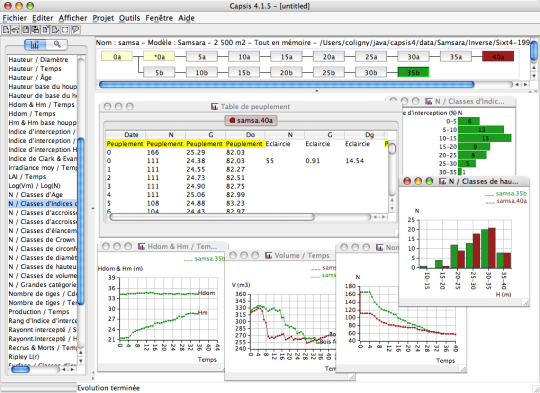Capsis
Contents
General System description
System name: Capsis - Computer Aided Projections of Strategies In Silviculture
Acronym: Capsis
Brief overview
Capsis is a software platform aimed at simulation growth and silvicultural treatments for decision making in forest management, forestry research (hypotheses testing, model evaluation) and educational purposes.
Scope of the system
- tool encourages decision maker to discover new problems or opportunities by exposing to new information or results
- tool helps decision makers in recognizing upcoming problems for which solutions have been developed previously
- tool allows decision maker to actively create new knowledge when faced with a new problem and to develop novel solutions
- tool allows decision maker to capture knowledge, making it available to decision makers who are seeking solutions from previously solved problems
System origin
- The first version was developped by Philippe Dreyfus between 1993-1999
- Since 1999 the platform is developed by François de Coligny, joined by Samuel Dufour in 2008
ETÇAP is in this moment ready to be used in some forest management planning units (Kızılcasu-Cide; Gürgendağ-Edremit; Honaz-Denizli and Akseki-İbradı) in Turkey and will be soon adapted to other Turkish regions after evaluation by the Forest Management Department in Turkish Forest Service
Support for specific issues
Inventory compilation, harvest scheduling, timber-water-carbon production or prediction, soil protection, yield prediction, biodiversity conservation, spatial planning
Support for specific thematic areas of a problem type
- Timber cruising
- Silvicultural
- Certification
- Conservation
- Development choices / land use zoning
- Policy/intervention alternatives
- Spatial layout of interventions
Capability to support decision making phases
(NOTE I do not quite know what to do with this, as I do not understand it myself, although it seems related to system use)
(Click here to see a more detailed explanation)
- Intelligence (The current conditions of the forest can be analysed with various management strategies to achieve targets and a spatially configured harvest schedules be prepared.)
- Design (The simulation tool runs the different management possibilities among the restrictions imposed by the input data to understand forest dynamics.
The optimization tool projects the current state of a forest into a target forest under various management prescriptions with objectives and constraints.)
- Choice (Heuristic tools are used in order to ensure the spatial layout of the best management option chosen by the manager. )
- Monitor (Not implemented.)
Related systems
- AROBEM (empirical growth and yield model inherent in ETÇAP)
- ETÇAPKlasik
- ETÇAPSimulation
- ETÇAPOptimization
- ETÇAPKombineOptimization
Data and data models
Typical spatial extent of application
The normal spatial application level of Capsis is the stand level but can be extended to the forest level for specific models.
Forest data input
Capsis input information are
- inventory data that can be imported from files
- simulated data calcultated by specific algorithms
Type of information input from user (via GUI)
Each model integrated in capsis has its own GUI. This gui allow to set the model input parameters. These parameters depends of the model. There are different type of inputs :
- Initial parameters
- Evolution parameters
- Intervention parameters
Models
Forest models
There are more than 40 models integrated in Capsis : see capsis models.
- stand models
- diameter class models
- distance independant tree models
- distance dependant tree models
Social models
-Not available yet
Decision Support
Definition of management interventions
Capsis supports different type of generic interventions :
- by age, by height, by diameter class...
Each model can also implements specific intervention mechanisms.
Typical temporal scale of application
The temporal depends of the model.
Types of decisions supported
Decision-making processes and models
Output
Types of outputs
- stand level table and graphical outputs showing the temporal changes of its parameters
- stand level 2D viewer
- stand level 3D viewer
Spatial analysis capabilities
- facilitates links to GIS with geotools java library
Abilities to address interdisciplinary, multi-scaled, and political issues
System
System requirements
- Operating Systems: Linux / Windows / Mac Os X
- Other software needed : Java 1.6
Architecture and major DSS components
Desktop application
Usage
Research level use
Computational limitations
System memory limitation
User interface
Capsis provides :
- an interactive graphical user interface
- a script mode (without gui) based on groovy
Documentation and support
See Capsis web site : vapsis web site
Installation
- a free and open source version is available on the web : http://capsis.cirad.fr/capsis/download
References
Cited references
